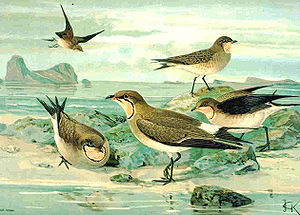Red-winged curlew
| Red-winged curlew | ||||||||||
|---|---|---|---|---|---|---|---|---|---|---|

Red-winged curlew ( Glareola pratincola ) |
||||||||||
| Systematics | ||||||||||
|
||||||||||
| Scientific name | ||||||||||
| Glareola pratincola | ||||||||||
| ( Linnaeus , 1766) |
The Collared Pratincole ( Glareola pratincola ) is a kind from the family of Brachschwalbe-like . It is very patchy spread from Africa to Asia. In Central Europe it is only a breeding and summer bird in Hungary , in other Central European regions it is not a very frequent stray visitor .
description
The red-winged curlew is about the size of a thrush and reaches a body length of 22 to 25 centimeters. The weight is 60 to 95 grams. It has a swallow-like flight. Their tail is slightly forked and the wings are partly rust-colored.
Red-winged curlews run fast, like plover-like, with sudden neck and head movements. The bobbing of the rear body is noticeable. In the hunt they are reminiscent of swallows.
habitat
Sun-dried swamps close to the water are ideal. The red-winged curlew can also be found in lean steppes with scattered ground vegetation.
Reproduction

The red-winged curlew breeds in colonies and changes location every year. Three, but sometimes only two, eggs are found in the clutch, which is laid in a hollow in the ground (e.g. a cattle step) in the last third of May. The offspring will fledge in July. The adults swarm around enemies.
food
In the cooler evening and morning hours, the birds hunt insects in swallow-like flight near herds of cattle . In the twilight these are mostly moths . While running, prey is picked up from the ground or poked from soft substrate.
Duration
The total European population was estimated at 10,000 to 18,000 breeding pairs at the beginning of the 21st century. European distribution centers are Spain (about 4,700 breeding pairs), Turkey (3,000 to 6,000 breeding pairs) as well as Portugal , Greece , Romania , Azerbaijan and the European part of Russia , where more than five hundred breeding pairs each breed.
In Central Europe, the red-winged curlew only breed in Hungary . Twenty to ninety breeding pairs were counted there at the beginning of the 21st century.
supporting documents
literature
- Hans-Günther Bauer, Einhard Bezzel and Wolfgang Fiedler (eds.): The compendium of birds in Central Europe: Everything about biology, endangerment and protection. Volume 1: Nonpasseriformes - non-sparrow birds. Aula-Verlag Wiebelsheim, Wiesbaden 2005, ISBN 3-89104-647-2 .
- Simon Delany, Derek Scott, Tim Dodman, David Stroud (Eds.): An Atlas of Wader Populations in Africa and Western Eurasia. Wetlands International , Wageningen 2009, ISBN 978-90-5882-047-1 .
Web links
- Glareola pratincola in the endangered Red List species the IUCN 2008. Posted by: BirdLife International, 2008. Accessed January 31 of 2009.
- Videos, photos and sound recordings of Glareola pratincola in the Internet Bird Collection
- Age and gender characteristics (PDF; 1.5 MB) by J. Blasco-Zumeta and G.-M. Heinze (English)

